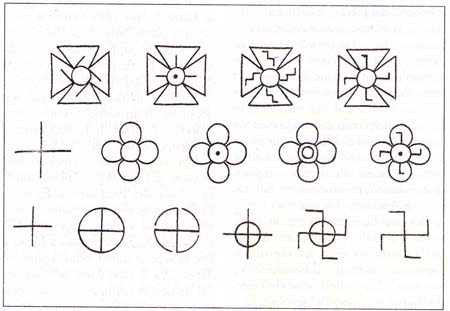 |

|
|
| The developments of the Cross symbol in Ancient Indian Traditions and Religions. In the second row it changes itself and becomes Lotus Flower; in the third row it becomes Swastika. This religious symbol dates from the earliest times (15.000 Before Christ); it goes back to the Magdalenian Culture and it spread worldwide. Incarna la dimensione esoterica della Religione (postglaciale) del Sole propria dei popoli Vedici. Swastikaembodies the esoteric dimension ofSun’s worship of Indo-European Veda people. “Swastika” is an anglicization word of the Sanskrit word “svastika”, meaning good luck or well-being. It was used by Hindus, Buddhists, Jains and other several ancient cultures (also in Atlantis, several scholars tell) for thousands of years, but it became known in all over the world through Tibetan culture. The swastika’s counterclockwise, adopted by Hitler’s N.S.D.A.P., is also the letter “G” in the medieval Northern European Runic Script. Also the Freemasonic Lodges took the letter as an important symbol, because “G” could stand for God, the Great Architect of the Universe who used Holy Geometry.The swastika is also an old emblem of the Ancient Scandinavian Gods of Thunder and Might (Thor, Donner, Perkunas), and for this reason the Latvians and Finnish both took the swastika as the symbol for their air forces when these people obtained independence after the 1914-1918 Great War. Swastika is nerve centre of 20th Century’s mysteries. In German pre-Nazi ideology was Guido von List to introduce this insignia for Neo-Pagan movements. The German ideologists, i.e. pre-nazi and National-Socialist intellectuals, did not use the Sanskrit word swastika, but called instead it as “Hakenkreutz”, which means <<hooked cross>>. |
 |
|
|